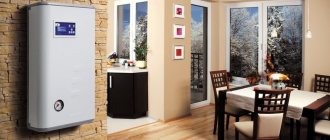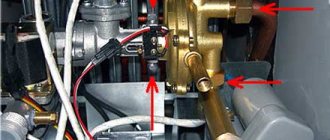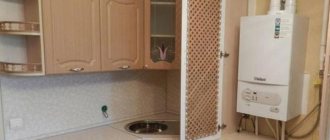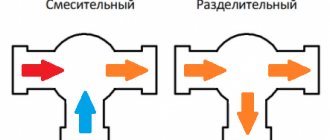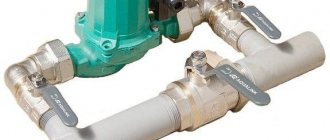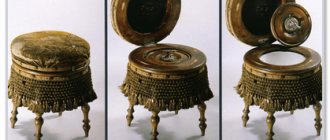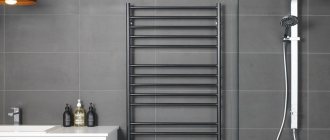Home / Gas boilers
Back
Published: November 27, 2019
Reading time: 11 min
0
2993
A modern heating system for an individual home is an indispensable component of living comfort. In order to create a reliable system, it is necessary to select a boiler unit that is capable of providing high-quality home heating.
Many owners of individual houses have recently sought to purchase a boiler not only for heating, but also for heating hot water. In order to provide all the necessary heat loads, you will need to know which gas boiler is best to choose for heating a private home.
- 1 Double-circuit or single-circuit
- 2 What to look for when choosing a boiler
- 3 Rating of gas boilers 3.1 TOP wall-mounted boiler units and their price as of November 1, 2019:
- 3.2 Rating of floor-standing gas boilers and their price as of November 1, 2019:
- 3.3 The best floor-standing boilers according to reviews
- 3.4 The best wall-mounted gas boilers
How does a gas boiler work?
The main classification of gas boilers according to the method of their installation:
- floor
- wall-mounted
The first ones are installed in any convenient place, and sometimes they are simply given a separate room, somewhere in the basement. A floor-standing boiler usually has a massive, sectional cast-iron heat exchanger. As a rule, such boilers have a power above 30 kW and are used to supply hot water and heat rooms larger than 50 sq. m. Its main drawback is that it takes up floor space in the room, and this is sometimes annoying, especially if the house is small.
In such cases, a wall-mounted gas boiler - it is hung on the wall, it has a simpler heat exchanger and less power.
Another characteristic feature of a boiler is related to the design of its chimney - the exhaust gas removal channel. There are two types of such channels:
- A chimney in the form of a structural element of a building, usually removed from the room vertically to the roof or an artificial chimney made of a heat-resistant pipe and very often running horizontally from the boiler to a window or opening in the wall. To create draft, a fan is installed in such a chimney, and the chimney is called turbine and the boiler system is called open. Its disadvantage is that the boiler burns oxygen from the room, which means it is necessary to provide an influx of fresh air.
- A closed chimney is made from a coaxial pipe - it allows for the removal of combustion products through an internal pipe, and the intake of fresh air through an external pipe. Such a chimney is also turbined to provide draft.
Burners for modern gas boilers use exclusively modulating ones - they ensure the maintenance of a constant water at the boiler outlet according to the task that the user selects with a regulator. The main task of the burner is to mix air and gas in proportions optimal for combustion, which ensures more complete combustion of gas, and therefore efficiency worthy of your efforts. For this indicator, values up to 98% have been achieved. The most durable burners are made of stainless steel, but they are also made of other materials, which you need to pay attention to when choosing a boiler.
One of the components that causes a lot of trouble for gas equipment designers is the ignition system. An essentially simple operation - bring an open flame to a stream of gas and the job is done - was difficult to implement in automatic mode. The igniter solved this problem. It is set on fire with a match and only once (and you know that the first match appeared in 1805) and then it burns constantly. When gas is supplied to the pilot area, the burner flares up with a “bright flame” and heats the water, and when the gas is turned off, the pilot always continues to burn (at our expense, of course) until it is needed again.
The situation did not improve much with the advent of piezo ignition - instead of a match, a “non-consumable” spark generator was used - a piezo element. But the igniter remained on guard, and this is at least an irrational gas consumption. The solution was electric ignition. It uses a sensor for water flow through the main line, which is triggered when the tap is turned on. For this purpose, an impeller is built into the water main, the rotation of the shaft of which leads to the generation of a spark, exactly the same as in the ignition system of a car.
Features of floor-standing gas boilers
Despite the good performance properties of wall-mounted boilers, floor-mounted gas heat generators continue to be popular, and there are several good reasons for this:
- Increased power . Due to their design features, floor-mounted heating boilers are much more powerful than their wall-mounted counterparts.
- Durability and low failure rate . It is the floor options that are the most reliable. One of the reasons is the cast iron heat exchanger, which can function for 20 - 30, and even 50 years.
- Ease of use, maintenance and overall cost-effectiveness . A floor-standing gas boiler for a home most often does not have built-in automation, and therefore has a simple design. Repairs, if suddenly needed, will not take much time and will be cheaper compared to wall-mounted equipment.
It is necessary to clarify that in the model range of both foreign and Russian manufacturers you can choose a non-volatile floor-standing boiler. In such devices, the coolant is capable of moving along the main heating circuit, which is responsible for heating the home, without a running pump.
Like any heating devices, even the best floor-mounted boiler, which is designed for heating a home, has several significant disadvantages. In addition to the dimensions already mentioned, such a heat generator must be installed in a suitably prepared boiler room as a separate room. In this case, not only a number of requirements are met in order to obtain permission to install gas equipment, but SNiP is also followed.
Floor-standing gas boilers for heating a private house may have one or two heating circuits. In the first case, the heat generator works only for heating, and in the second it is also connected to the hot water system, providing consumers with hot water for domestic needs. By the way, single-circuit floor-standing boilers of both foreign and Russian production can work in tandem with an indirect heating boiler, which is purchased separately. The latter, in this case, works on hot water supply.
In terms of reliability, double-circuit boilers are inferior to single-circuit boilers, since their design is noticeably complicated by two separate heat exchangers for each task, or one divided into segments. The latter is the so-called bithermic heat exchanger. Here, in one building, there is a separate movement of both the coolant and hot water for domestic needs.
The heat exchanger material is another parameter by which heat generators differ from each other. Many ratings of the best floor-standing gas boilers contain all the options listed below, since each of them has its own characteristics:
- Cast iron - as already mentioned, they have a long service life, are resistant to the aggressive effects of coolant and thermal shock. The disadvantages include excessive fragility, which must be taken into account both during operation and during transportation. For such gas heating boilers, the difference between the supply and return temperatures should not exceed 45 degrees.
- Steel ones are stronger and lighter than the previous version, however, they are noticeably susceptible to burnout and corrosion. The service life is (with proper operation) 10 – 15 years. For home gas boilers with heat exchangers made of steel, the temperature should not fall below the “dew point” to avoid condensation. This significantly extends the service life of the equipment.
- Copper - with good thermal conductivity and corrosion resistance, low weight. It seems that the best floor-standing gas boilers should be equipped with copper heat exchangers, but in reality this happens extremely rarely, since the material wears out excessively.
To determine for yourself which of the floor-standing gas heating boilers is better in terms of full efficiency, it is necessary to mention that there are so-called condensing heat generators.
Compared to the traditional convection type of heating equipment, their efficiency is noticeably higher, since the design provides for the return of part of the thermal energy that usually flies out into the chimney in the literal sense.
Important! A good condensing boiler gives an increase in efficiency of 10 - 1%. Its design includes a so-called water economizer, which is an additional heat exchanger. The steam contained in the gas combustion products leaving the boiler through the chimney condenses on it. In this cunning way, it is possible to retain part of it and use it to heat the coolant. To achieve a certain equipment power, it is now necessary to consume less fuel, which is why the condensing boiler is the most economical.
The information presented above is enough to determine which floor-standing gas boiler is best to purchase for organizing autonomous home heating. Before purchasing a particular model, it is recommended to study its review, which will provide more information on the topic.
It should also be taken into account that Russian gas heating boilers, in some respects, are able to compete with foreign analogues, perhaps not in manufacturability, but certainly in cost and design simplicity.
How many contours to choose
Perhaps the most serious difference between gas boilers and gas burners is that the boilers were initially designed to produce hot water not only for their own needs, but also for heating.
Each of these functions has its own peculiarity: own needs are an impulse consumer; heating circuit - requires constant heating. The problem can be easily solved. Wall-mounted boilers have one heat exchanger, but both circuits are heated by it alone - either one or the other. An open circuit has the advantage - as soon as the hot water tap is turned on, all heating is switched to this circuit and the outgoing hot water is heated, while the heating circuit, as they say, “will wait, nothing will happen to it.” Turning off the hot water stops heating the open circuit and the heating starts again.
Double-circuit boilers with two heat exchangers have a different heating circuit. In normal mode, only the heating circuit is heated by its heat exchanger. When hot water is turned on, the heating circuit is closed and water is supplied to the circuit with another heat exchanger as long as it is turned on. Forced downtime of the heating system does not affect the quality of heating - both the dishes are clean and the house is warm.
It is possible that your need for hot water is higher than the boiler can provide - that’s okay. Most boilers allow the installation of an external boiler. This need arises especially often when using wall-mounted boilers.
Criteria for choosing a gas boiler for a private home
When buying a gas boiler, you need to take into account the conditions of use and the requirements for the system. First of all, it is necessary to take into account the area that needs to be heated; based on this, the boiler power is approximately estimated based on the fact that 1 kW of power is needed to heat 10 m2.
The next aspect when choosing equipment is the need for hot water supply in the house, as well as the amount of hot water consumed. The presence and condition of the chimney also has a significant impact on the parameters of the gas boiler.
In addition, when designing a heating system, it is necessary to take into account the gas pressure in the main pipelines and the presence of thermal insulation materials on the walls and other areas of a private house.
Since both domestic and foreign manufacturers are currently widely represented on the gas equipment market, one should take into account the fact that although imported boilers have a more attractive appearance and are equipped with greater control capabilities, domestic units are adapted to real operating conditions.
Security and automation systems
A boiler is, in principle, high-risk equipment. The use of gas, a burning flame, or hot water when “something like that” fails can lead to many troubles. Cases of carbon monoxide poisoning look especially wild - an incident out of nothing, but often very serious. Therefore, proper operation, timely maintenance, compliance with the technical regulations set out in the operating instructions are your primary responsibility and, above all, for your own safety.
Boilers have many protective systems that are installed on all products without exception. This is protection against flame extinction, protection against exceeding the outlet temperature, against a drop in gas pressure, against water and gas leaks. But modern boilers additionally have many more monitoring and warning systems about future faults based on diagnostics using microprocessor systems. This includes a draft control system, a burner wear control unit, etc. Such a boiler can already be classified as a smart family. If the boiler user also happens to be at the smart level, then everyone wins.
Single-circuit and double-circuit models of gas boilers
Regardless of the installation method, gas devices can be divided into single-circuit and double-circuit.
Single-circuit gas boiler
can be used to provide heat to housing and is not used for water supply, so the feasibility of using such a device is very doubtful.
Double-circuit gas boiler
You can choose for heating a private house, and for heating water. These products are in greatest demand. Despite the fact that the price of double-circuit gas boilers is significantly higher than the price of single-circuit units, given the fact that in parallel with heating the problem of heating water for domestic needs is solved, it is advisable to take double-circuit devices.
Selecting boiler power
If you are choosing a boiler for a private home, then you need to decide on the heating area. The simplest approximate option for premises in ordinary urban buildings with a ceiling height of less than 3 m is done as follows:
- take a specific consumption of 1 kW per 10 sq. m. area of the house;
- divide the area by 10, round the result up;
- the resulting base power is increased by 25% and they sit down at the catalogs to select a specific boiler model.
If you obviously have a house with increased heat loss, then increase the required power by another 25% or deal with the problem of insulating the house with “passive heating” - choosing and installing wall insulation, installing “warmer” windows, insulating floors, ceilings, etc. Of course , specialists from a company that install gas boilers can do this much more accurately (and when completing a boiler installation project, they will definitely do this), but most likely they will confirm your calculation result.
How much hot water will boilers of different power produce? Low power boilers (up to 15 kW) can easily provide hot water and heating to a 1-2 room apartment. If the number of residents is no more than 2 people, then a hot water output of up to 12 l/min will be enough for them.
For a family of 4 people, the average water consumption is at least 15 l/min, which is possible for boilers with a capacity of 20-25 kW. The upper power level of household boilers is approximately 35-40 kW, which means up to 20 l/min of hot water and a heated area of up to 200 sq. m.
Contrary to the natural desire of some users to “just get a more powerful boiler and not bother,” it should be noted that a boiler operating under “underload” fails just as quickly as an overloaded one. This happens for various reasons, for example, due to the fact that instead of a continuous heating mode of the heating circuit, it switches to a pulse mode, because due to the large power reserve, the boiler quickly heats the house and the automation turns it off. This is especially bad for burners and the chimney. Burners do not really like alternating heating/cooling cycles, and the chimney easily accumulates condensation when cooling. Both of these are a direct path to failure of very expensive components. In addition, a more powerful boiler costs more. Really, it sounds a lot like “money down the drain”?
Calculation of the power of a condensing gas boiler
In terms of efficiency, a condensing gas boiler is better than a convection boiler, however, its cost is on average 30% higher. In order to buy a heating unit suitable for the conditions of use, without overpaying for excess power, you need to correctly calculate how much it will be needed.
Gas floor-standing boilers, like wall-mounted boilers, are selected according to the well-known principle, according to which 1 kW of thermal energy can heat an area of 10 sq.m. If we take into account the maximum temperature of the supply line, it turns out that for a house of 200 sq.m. you will need a 24 kW condensing boiler.
The above calculation is very approximate, since to accurately determine the required power, the height of the ceilings, the climatic features of the region, and the total heat losses of the building, which depend on many factors, are taken into account. However, the connection between square meters and kilowatts allows you to navigate the whole variety of heating equipment at the first stage of selection.
